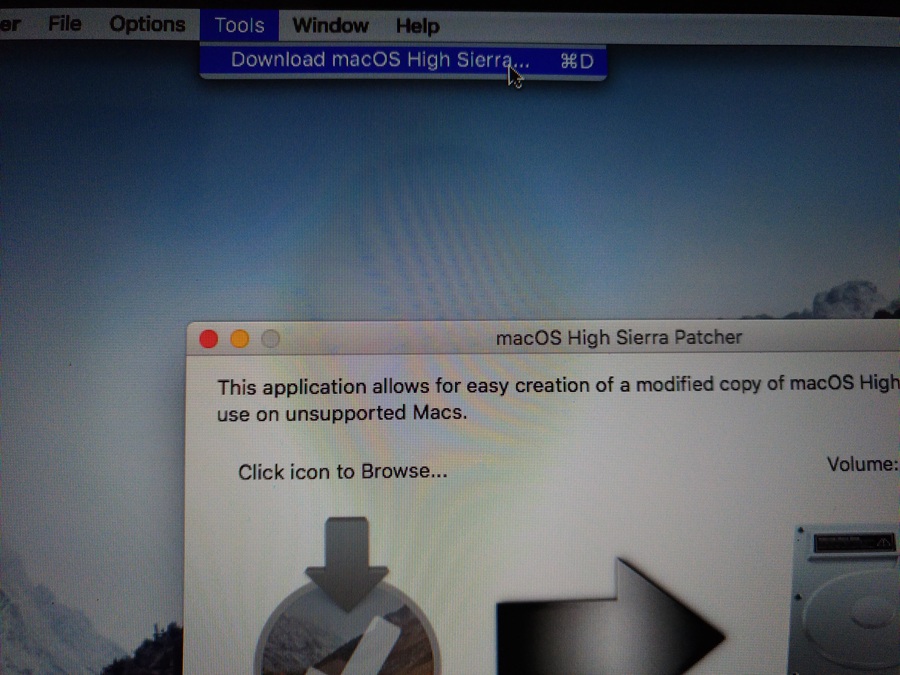
- Macos sierra patcher no tools menu mac os#
- Macos sierra patcher no tools menu install#
- Macos sierra patcher no tools menu full#
- Macos sierra patcher no tools menu software#
Macos sierra patcher no tools menu full#
'MacOS High Sierra Patcher' is for those with unsupported Mac and Hackintosh users, but any Mac user can use the application to download the full installer file from Apple servers. Next, select your USB drive in the Target Volume list, and click 'Start Operation.' Find the 'install macOS High Sierra.app' file you have downloaded, it is a complete installer with all available Content / Resources / Toolkit. Open the 'macOS High Sierra Patcher' tool, and browse for your copy of the macOS High Sierra Installer App.Ensure that the tool successfully verifies the app. Insert your desired USB drive, open Disk Utility, and format it as OS X Extended (Journaled). Please note that this project is no longer supported by the developer. MacOS Patcher (discontinued) More advanced users may consider using macOS Patcher, which is a command line-based tool that provides the same hardware support, while also adding support for MacBook4,1 systems. Please consider making a donation to help support development.
Macos sierra patcher no tools menu software#
Note: While the software is classified as free, it is actually donationware.
Macos sierra patcher no tools menu install#
If you do not have Patch Updater installed, but would like it, you can download and run the script found here to do so.MacOS Sierra Patcher is an easy-to-use tool that allows anyone to install macOS Sierra on unsupported Macs. This program will alert you when new updates to patches are available for your machine, and will prompt you to install them.


If selected in the macOS Post Install tool, your High Sierra install will have a program named "Patch Updater" located in your /Applications/Utilities folder. When it reboots, it should now boot into a fully working copy of macOS High Sierra. This isn't necessary under most circumstances.ġ1. If for some reason the system fails to work correctly after rebooting, boot back into your installer drive, run the post install patch again, and select "Force Cache Rebuild" before rebooting. It may sit there for a few moments rebuilding caches before rebooting. Select the volume you have just installed macOS High Sierra on, and click "Patch." When it finishes patching, click "Reboot". The "i" button next to each patch will show more details about the respective patch.ġ0. You can also select other patches of your choosing. The optimal patches will be selected for you based on the model you select. In the application, select the Mac model you are using. This time, open the "macOS Post Install" application.ĩ. When the install completes, reboot back onto the installer drive. Install macOS normally onto the desired volume.Ĩ. A demo of the modified booting process can be viewed here.ħ.

It is not quite as clean as native booting, but will not cause any issues while running High Sierra. If you decide to use APFS, a custom booting method will be installed by the post-install tool, as the firmware of these unsupported machines does not natively support booting from APFS volumes. It is recommended that you only use APFS if the target drive is an SSD. Please note that if you use APFS, you will not have a bootable Recovery partition. If formatting an entire drive, ensure GUID is selected.
Macos sierra patcher no tools menu mac os#
Select the disk or partition you want to install on, and erase it, ensuring to use either Mac OS Extended (Journaled), or APFS as the filesystem type. When the installer boots, open Disk Utility from the Utilities menu, or by double-clicking it in the Utilities window on the bottom left corner of the screen.Ħ. Otherwise, you can simply skip these steps and install to your volume containg a previous version of OS X, and it'll do an in-place upgrade.ĥ. Note: Only perform steps 5 and 6 if you intend to do a clean install. When the operation completes, boot your target unsupported Mac off the USB drive you just created by holding down the Option key while turning on the machine, and selecting the drive.
/article-new/2019/12/2catalina-patcher-tool-.jpg)
Next, select your USB drive in the Target Volume list, and click "Start Operation."Ĥ. *Ensure that the tool successfully verifies the app.ģ. Open the "macOS High Sierra Patcher" tool, and browse for your copy of the macOS High Sierra Installer App. Insert your desired USB drive, open Disk Utility, and format it as OS X Extended (Journaled).Ģ. While it works and is fully usable, High Sierra detects it as just a standard mouse, preventing you from changing some trackpad-oriented settings.ġ. The trackpad in the MacBook5,2 isn't fully supported in High Sierra. View changelog and download older versions here A USB drive that's at least 8 GB in size In the Menu Bar, simply select "Tools > Download macOS High Sierra." This can be obtained from the Mac App Store using a machine that supports High Sierra, or by using the built-in downloading feature of the tool. A copy of the macOS High Sierra Installer App.


 0 kommentar(er)
0 kommentar(er)
